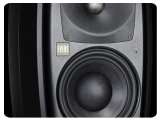
Event Electronics unveils the Opal, a new nearfield monitoring system which provides a raw response of 30Hz-10KHz and a power handling of 1000 watts.
After purchasing Event Electronics in 2006, Peter Freedman set upon a quest to redefine the nearfield studio monitor, to provide sound recording artists and engineers with a truly reference monitoring system. He approached experienced product designer Marcelo Vercelli, formerly of Mackie, RCF and KV2, with his plans for the future of Event.
After two years of engineering, Marcelo and his R&D team presents the Opal. Its high-power neodymium motor offers 24mm of linear excursion which results in up to four times the output of some of the most expensive studio monitors. This gives the listener a more detailed and high level of high-speed bass, say Event.
The Opal's patented X-Coil configuration increases the EX8 driver speed and lowers harmonic distortion by up to 18dB, which results in mid-range accuracy that is supposed to "surpasses even the finest three-way studio monitors". The EX8 bespoke cone material provides extension and control to complete this driver of a new type.
The EBT1 tweeter combines ultra-light and rigid beryllium with one of the most powerful neodymium motors of any system available to provide the Opal with unbelievably high SPL capabilities while minimising any distortion. It is mounted in a fully rotatable waveguide to provide complete versatility in application.
The Opal cabinet is completely machined from aluminium to minimise resonance, and curved in a combination of complex radii, minimising flat or cornered sections that can cause diffraction issues. A no compromise approach to port design has resulted in front mounted variable impedance bass reflex ports that eliminate problems created by rear reflection ports that rely on room acoustics, and also air distortion artefacts found in conventional front ported systems. This is supposed to give the Opal "fast, deep and accurate bass".
The Opal's drive electronic system is purely analogue, providing 750 watts of power in two-way configuration and giving the Opal an impressive "transient response and low distortion", or so we are told. Multiple levels of protection for power and over excursion allows the user to drive the Opal hard without concern. A proprietary expansion system allows for the addition of interface modules, including AES/EBU.